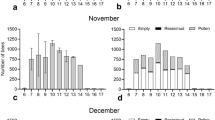Abstract
In the honey bee colony queen rearing is usually suppressed by releaser effects of the queen's pheromone. This is part of the dominance hierarchy maintaining the monogynous homeostasis. Under queenless conditions, the queen's control over the construction of emergency queen cells by the workers can be substitued by exposure to only one component of the mandibular pheromone secretion of a queen, the main compound (E)-9-oxo-2-decenoic acid. A novel and simple synthesis of (E)-9-oxo-2-decenoic acid is described, and a bioassay was developed by which a dose-dependent effect of synthetic (E)-9-oxo-2-decenoic acid presented on a dummy bee was evaluated.
Similar content being viewed by others
Abbreviations
- 9-ODA:
-
(E)-9-oxo-2-decenoic acid
References
Adler A (1990) Königin-Pheromon bei der Honigbiene: Ontogenetische Muster von Sekretkomponenten der Mandibeldrüse und zwei Biotests zu Releaser-Effekten bei Arbeiterinnen. Thesis, Department of Developmental Biology, University of Tübingen
Blom J van der (1992) Individual involvement in queen-attending of worker honeybees. Insect Soc 39:237–249
Boch R, Lensky Y (1976) Pheromonal control of queen rearing in honeybee colonies. J Apic Res 15:59–62
Butler CG (1961) The scent of queen honeybees (A. mellifera) that causes partial inhibition of queen rearing. J Insect Physiol 7:258–264
Butler CG, Paton PN (1962) Inhibition of queen rearing by queen honey bees (Apis mellifera L.) of different ages. Proc R Entomol Soc (Lond) A 37:114–116
Butler CG, Callow RK, Johnson NC (1962) The isolation and synthesis of queen substance, 9-oxodec-trans-2-enoic acid, a honeybee pheromone. Proc R Entomol Soc (Lond) B 155:417–432
Butler CG, Callow RK, Greenway AR, Simpson J (1974) Movement of the pheromone, 9-oxodec-2-enoic acid, applied to the body surfaces of honeybees (Apis mellifera). Entomol Exp Appl 17:112–116
Chaudhry M, Johansen CA (1971) Management practices affecting efficiency of the honey bee, Apis mellifera. (Hymenoptera: Apidae). Melanderia 6:1–32
Doolittle RE, Blum MS, Boch R (1970) Cis-9-oxo-2-decenoic acid: synthesis and evaluation as a honey bee pheromone and masking agent. Ann Entomol Soc Am 63:1181–1185
Engels W (1986) The concept of chemical communication in arthropods as realized in social bee reproduction. Adv Invert Reprod 4:285–296
Free JB (1987) Pheromones of social bees. Chapman and Hall, London
Hildebrandt H, Kaatz H-H (1992) Antennal perception of the honey bee queen pheromone and its effect on juvenile hormone biosynthesis in workers. In: Mauchamp B et al (eds) Insect juvenile hormone research. INRA, Paris, pp 73–82
Huber F (1814) Nouvelles observations sur les abeilles. 2nd edn, translation 1926. Dadant, Hamilton, Ill.
Huckin SN, Weiler L (1974) Alkylation of dianions of β-keto esters. J Am Chem Soc 96:1082–1087
Kaatz H-H, Hildebrandt H, Engels W (1992) Primer effect of queen pheromone on juvenile hormone biosynthesis in adult worker honey bees. J Comp Physiol B 162:588–592
Kaminski L-A, Slessor KN, Winston ML, Hay NW, Borden JH (1990) Honeybee response to queen mandibular pheromone in laboratory bioassays. J Chem Ecol 16:841–850
Mori K (1992) The total synthesis of natural products, vol 9. ApSimon J (series ed) Wiley, New York
Naumann K (1991) Grooming behaviours and the translocation of queen mandibular gland pheromone on worker honey bees (Apis mellifera L.). Apidologie 22:523–531
Naumann K, Winston ML, Slessor KN, Prestwich GD, Webster FX (1991) Production and transmission of honey bee queen (Apis mellifera L.) mandibular gland pheromone. Behav Ecol Sociobiol 29:321–332
Seeley TD (1979) Queen substance dispersal by messenger workers in honeybee colonies. Behav Ecol Sociobiol 5:391–415
Shaposhnikova G, Gavrilov BN (1975) Increasing the attractiveness of queens (to workers) and their introduction into colonies (in Russian). In: Skirkyavichyus AV (ed) Insect chemoreception 2, pp 181–184
Slessor KN, Kaminski L-A, King GGS, Borden JH, Winston ML (1988) Semiochemical basis of the retinue response to queen honey bees. Nature 332:354–356
Slessor KN, Kaminski L-A, King GGS, Winston ML (1990) Semiochemicals of the honeybee mandibular glands. J Chem Ecol 16:851–860
Velthuis HHW (1976) Egg laying, aggression and dominance in bees. Proc XV Int Congr Entomol (Washington D.C.) pp 436–449
Velthuis HHW (1985) The honeybee queen and the social organization of her colony. Fortschr Zool 31:343–357
Verheijen-Voogd C (1959) How worker bees perceive the presence of their queen. Z Vergl Physiol 41:527–582
Whiffler LA, Hepburn HR (1991) Inhibition of queen cell construction in the Cape honeybee, Apis mellifera capensis. Apidologie 22:229–236
Winston ML, Slessor KN, Willis LG, Naumann K, Higo HA, Wyborn MH, Kaminski L-A (1989) The influence of queen mandibular pheromones on worker attraction to swarm clusters and inhibition of queen rearing in the honey bee (Apis mellifera L.). Insect Soc 36:15–27
Winston ML, Higo HA, Slessor KN (1990) Effect of various dosages of queen mandibular gland pheromone on the inhibition of queen rearing in the honey bee (Hymenoptera: Apidae). Ann Entomol Soc Am 83:234–238
Author information
Authors and Affiliations
Additional information
In memoriam Viktor Schwartz (1907–1992), Professor of Zoology and Developmental Biology, University of Tübingen, who introduced smoothened bee stings into microsurgery
Rights and permissions
About this article
Cite this article
Engels, W., Adler, A., Rosenkranz, P. et al. Dose-dependent inhibition of emergency queen rearing by synthetic 9-ODA in the honey bee, Apis mellifera carnica . J Comp Physiol B 163, 363–366 (1993). https://doi.org/10.1007/BF00265639
Accepted:
Issue Date:
DOI: https://doi.org/10.1007/BF00265639




